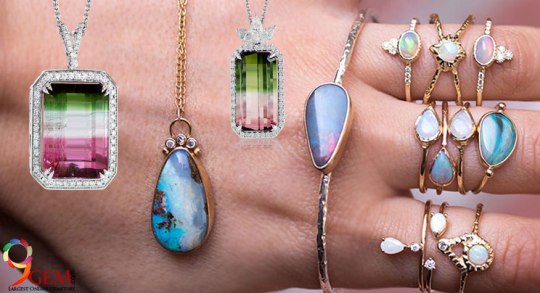
Individuals born in October get to choose between two birthstones—tourmaline and opal. Each gem then unveils nearly limitless possibilities, as each one comes in a rainbow of shades and color combinations.
In fact, both of October’s birthstones came to earth through a journey involving rainbows, according to legend.
Between tourmaline (whose color depends on trace elements in its chemical makeup) and opal (which diffracts light to show a play of multiple colors), October’s birthstones offer a full spectrum of gems to suit anyone’s personal tastes.
 OPAL
OPAL
 |
| Lightning Ridge Collection |
The name “opal” originates from the Greek word opallios, which meant “to see a change in color.” The Roman scholar Pliny used the word opalus when he wrote about this gem’s kaleidoscopic “play” of colors that could simulate shades of any stone.
Opal’s characteristic “play-of-color” was explained in the 1960s, when scientists discovered that it’s composed of microscopic silica spheres that diffract light to display various colors of the rainbow. These flashy gems are called “precious opals;” those without play-of-color are “common opals.”
Dozens of opal varieties exist, but only a few (like Fire Opal and Boulder Opal) are universally recognized. Opals are often referred to by their background “body color”—black or white.
Opal’s classic country of origin is Australia. Seasonal rains soaked the parched outback, carrying silica deposits underground into cracks between layers of rock. When the water evaporated, these deposits formed opal. Sometimes, silica seeped into spaces around wood, seashells, and skeletons, resulting in opalized fossils.
Since opal was discovered in Australia around 1850, the country has produced 95 percent of the world’s supply. Opal is also mined in Mexico, Brazil, Honduras, Ethiopia, the Czech Republic, and parts of the U.S., including Nevada and Idaho.
The water content of opal can range from three to 21 percent – usually between 6 and 10 in the gem-quality material. This, combined with a hardness of only 5.5 to 6 on the Mohs scale, makes opal a delicate gem that can crack or “craze” under extreme temperature, dehydration, or direct light.
Wearing an opal is well worth the extra care, though. For centuries, people have associated this gem with good luck. Though some recent superstitions claim that opals can be bad luck to anyone not born in October, this birthstone remains a popular choice.
 |
| Lika Behar Collection |
According to Arabic legend, opals fell from the sky in bolts of lightning. Australian aborigines, meanwhile, believed that the creator came to earth on a rainbow, leaving these colorful stones where his feet touched the ground.
In 75 AD, the Roman scholar Pliny compared opals to volcanoes and vibrant paintings, noting that their dancing “play” of color could simulate shades of any gems.
During the Middle Ages, people believed that the opal possessed the powers of each gemstone whose color appeared in its sheen, making it a very lucky stone.
But Sir Walter Scott’s 1829 book, “Anne of Geierstein,” transformed opal’s lucky perception. The story featured an enchanted princess who wore an opal that changed colors with her moods. A few drops of holy water extinguished the stone’s magic fire, though, and the woman soon died.
People began associating opals with bad luck. Within a year after the publication of Scott’s book, opal sales in Europe fell by 50 percent.
Discoveries of opal deposits in Australia revived opal’s image after 1850. The outback began producing 95 percent of the world’s supply, and many of its finest opals.
The world’s largest and most valuable opal, “Olympic Australis,” came from Coober Pedy, Australia in 1956, during the Olympic Games in Melbourne. Valued at $2.5 million in 2005, this gem measures 11 inches long and weighs 17,000 carats (7.6 pounds).
After scientists discovered the spherical silica structure of opal in the 1960s, they figured out how to synthesize it in 1974.
Since then, opal has gained more popularity through recent discoveries in Ethiopia. Material mined in the Shewa Province in 1994 wasn’t desirable because it was dark and tended to crack easily. But deposits in the Wollo Province, discovered in 2008, brought vivid play-of-color displays to the market.
Australia’s depleting supplies of classic opal impact the price of this uniquely kaleidoscopic gem. Because its flashing play-of-color can suit many changing moods and tastes, the opal stays in high demand.
 TOURMALINE
TOURMALINE
 |
| Supreme Jewelry |
The name “tourmaline” comes from the Sinhalese words tura mali, which mean “stone of mixed colors.” As its name implies, tourmaline stands apart from other gems with its broad spectrum of colors in every shade of the rainbow.
Tourmaline is not one mineral, but a fairly complex group of minerals with different chemical compositions and physical properties. Certain trace elements produce distinct colors, and many resulting varieties have their own names:
- Schorl or black tourmaline is rich in iron, which causes dark shades from deep brown to bluish-black. This variety makes up 95 percent of all tourmaline, though most of it isn’t gem-quality. School, in particular, is said to have protective powers against harmful radiation, toxins, and anxiety.
- Dravite or brown tourmaline is rich in magnesium, which causes colors ranging from brown to yellow. It’s named for the Drave District of Carinthina (now Slovenia) where it’s found.
- Elbaite offers the widest range of gem-quality tourmaline colors, due to lithium traces combined with other coloring elements:
- Rubellite or red tourmaline is caused by manganese; but if the color becomes less vibrant under different light sources, it may be called a pink tourmaline.
Indicolite or blue tourmaline can appear purplish-blue or bluish-green, depending on the amount of iron and titanium. - Verdelite or green tourmaline can resemble emerald, but if its color is caused by chrome and vanadium, it’s called a chrome tourmaline.
- Paraíba tourmaline is a vividly colored purplish or greenish-blue variety found in Paraíba, Brazil. It’s the most recently discovered, and because of its desirably intense colors, it’s one of the most valuable.
- Achroite or colorless tourmaline is rare.
- Parti-colored tourmaline displays more than one color, due to chemical fluctuations during crystallization. A common color combination is green and pink. These are often cut in slices to reveal a red center surrounded by a green rim, earning the name “watermelon tourmaline.”
- Rubellite or red tourmaline is caused by manganese; but if the color becomes less vibrant under different light sources, it may be called a pink tourmaline.
Tourmaline is mined in Brazil, Sri Lanka, Nigeria, Mozambique, Madagascar, Afghanistan, Pakistan, and the U.S.—mainly Maine and California.
Tourmaline is desirable because of its sheer range of color options. Combined with a good hardness of 7 to 7.5 on the Mohs scale, tourmaline makes very wearable jewelry.
One of these gem’s most impressive traits is its ability to become electrically charged through heat (pyroelectricity) and through pressure (piezoelectricity). When charged, tourmaline can act as a magnet by oscillating, and by attracting or repelling particles of dust.
Ancient magicians used black tourmaline as a talisman to protect against negative energy and evil forces. Today, many still believe that it can shield against radiation, pollutants, toxins, and negative thoughts.
 |
| Gregg Ruth |
Egyptian legend tells that tourmaline found its famed array of colors when, on its journey up from the earth’s center, it passed through a rainbow. Because of its colorful occurrences, tourmaline has been confused with other gems throughout history.
In the 1500s, a Spanish conquistador found green tourmaline in Brazil—which he mistook for emerald. His error held until the 1800s when mineralogists finally identified tourmaline as its own mineral species.
Variations of the name “schorl” may have been used to describe black tourmaline even before 1400. The name comes from a village in Saxony, Germany, (now called Zschorlau) near a mine with black tourmaline deposits.
The Dutch East India Company brought Sri Lankan tourmaline to Europe for centuries before traders realized it was the same mineral as schorl.
American tourmaline deposits caused the gem’s spike in popularity. In 1876, mineralogist George Kunz launched a craze when he sold green tourmaline from Maine to Tiffany & Co.
In the early 1890s, tourmaline was reported in California—where Native Americans had, for centuries, given certain colors of the gem as funeral gifts.
At that point, China represented the biggest market for tourmaline. The Chinese Empress Dowager Cixi was particularly fond of pink tourmaline, and she purchased large quantities of it from deposits in San Diego County.
The Chinese market was so critical to tourmaline, in fact, that when the Chinese government collapsed in 1912, it took tourmaline trade down with it.
Brazilian tourmaline discoveries in the 1980s and 90s reignited interest in this gem because material mined in Paraíba displayed such striking neon greens, radiant blues, and vivid violets. This region has produced the world’s finest, most valuable specimens of tourmaline—including the world’s largest, weighing 191.87 carats.
While plenty of tourmalines is mined around the world, it’s rare to find fine gem-quality tourmaline in bright colors. This range of material means that the price of tourmaline can vary almost as much as the color.
Source: https://www.americangemsociety.org/page/octoberbirthstones


 OPAL
OPAL TOURMALINE
TOURMALINE